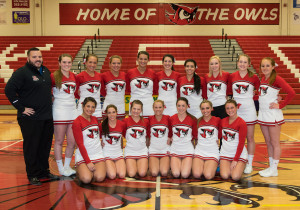Making the Grade: The All-Star to College Transition
High school is a busy time for competitive athletes, particularly at the start of junior year when attention turns to college. That vital next step comes with a hearty to-do list: SATs, letters of recommendation, college visits and applications. And if you’re a cheerleader, that list includes another big question: what’s next in my cheer career? While the answer may seem simple (collegiate cheer), the process is not. That’s why CheerProfessional reached out to several coaches to gather a helpful list of do’s for gym owners and coaches alike. Here’s what we found out:
 Do begin this conversation ASAP. “The earlier the better, depending on the skill level,” says Chris Fecteau, who has coached both high school and all-star cheer and is presently the Head Coach at Keene State College. Like many coaches, he recommends starting college-focused efforts by the beginning of junior year, since the process includes a hefty amount work both on and off the mat.
Do begin this conversation ASAP. “The earlier the better, depending on the skill level,” says Chris Fecteau, who has coached both high school and all-star cheer and is presently the Head Coach at Keene State College. Like many coaches, he recommends starting college-focused efforts by the beginning of junior year, since the process includes a hefty amount work both on and off the mat.
Do put a system in place. “I have a separate meeting for juniors and seniors to discuss the college tryout process at the beginning of year,” says Melissa Hay, who coaches the high school cheerleading program at University School of Nova Southeastern University. Hay also asks her cheerleaders to make a short list of potential schools, keeping in mind that academics—not cheer—should drive the list. “Academics have to be the priority,” says Hay. “I always say to them, ‘You need to have a career path. What’s your end game going to be?’”
Both Hay and Dave Perry, an all-star coach at Intensity Cheer Elite, follow info sessions with individual meetings to assess the needs of each athlete, developing a plan that may range from one-on-ones to writing personalized letters of recommendation and helping to line up essential open practices that enable athletes to fine-tune tumbling skills on collegiate cheer surfaces like hardwood and grass.
 Do advise athletes to do their research. Knowing the details of a school’s cheer program before tryouts is vital, according to King Harrison, skills coach at Georgia Tech and former coach at Stingray Allstars.
Do advise athletes to do their research. Knowing the details of a school’s cheer program before tryouts is vital, according to King Harrison, skills coach at Georgia Tech and former coach at Stingray Allstars.
Instructing athletes to visit each school’s cheer website will provide them with a wealth of knowledge, such as details on upcoming clinics and tryouts; links to videos (like crowd highlight tapes that show the type of stunting and tumbling athletes may be expected to hit); and, most importantly, what it means to be “game day” ready.
Do teach skills beyond tumbling and stunting. While many teams like Georgia Tech and Keene State attend national competitions, collegiate cheer’s number one focus is game day. This makes a tough transition for competition-driven All Stars, says Fecteau.
To ease that transition, encourage athletes to learn sideline cheers, fight songs and chants before heading into tryouts. Additionally, focus on the development of attitude, presentation and “coach-ability”—all of which play a determining role in a selection process that utilizes a “true cut.”
 Do advise of scholarship opportunities. Collegiate programs typically fall into one of three tiers, according to Fecteau: programs with a little out-of-pocket expense and active fundraising; programs that are fully funded but lack scholarships; and programs that are fully funded with scholarships.
Do advise of scholarship opportunities. Collegiate programs typically fall into one of three tiers, according to Fecteau: programs with a little out-of-pocket expense and active fundraising; programs that are fully funded but lack scholarships; and programs that are fully funded with scholarships.
Because of this variation, it’s important for athletes to make inquiries about financial packages during school visits. Equally important is for coaches to stay abreast of independent scholarship opportunities offered; one great example; is the USASF scholarship, which is open to “any college-bound senior that is a USASF Athlete Member and participates with any USASF member program.”
Do address this question: Collegiate Cheer and/or All Star Open? For those interested in a professional career in cheer or simply a competition-driven experience, All Star Open may be the only way to go. But for those seeking a once-in-a-lifetime opportunity, collegiate cheer may be too important to pass up. “You can cheer all-stars the rest of your life. You cannot cheer for college the rest of your life,” points out Fecteau.
Hay agrees: “I could not imagine not having that experience in my life. It opened so many doors for me.” And she’s quick to point out—athletes don’t always have to choose. Many collegiate cheerleaders are also members of all-star open teams.
But Fecteau cautions that “increased [odds] of injury and burnout if the seasons run too close” make some programs wary of this idea. As such, advising athletes to broach this conversation during initial school visits is wise. `
Do bask in a job well done. Gym owners and coaches are often so busy that adding the title of “college guidance counselor” to an already long list of responsibilities can feel overwhelming. However, many cheer professionals choose to take on the challenge anyway, having grown attached to their graduating athletes and invested in their ultimate success.
And the efforts pay off—while the process may prove time-consuming, the rewards are infinitely satisfying. Admits Perry, “It’s one of the best feelings to get a text message or email from an athlete thanking me for helping them meet their goals.”
–Carmen Rodriguez







